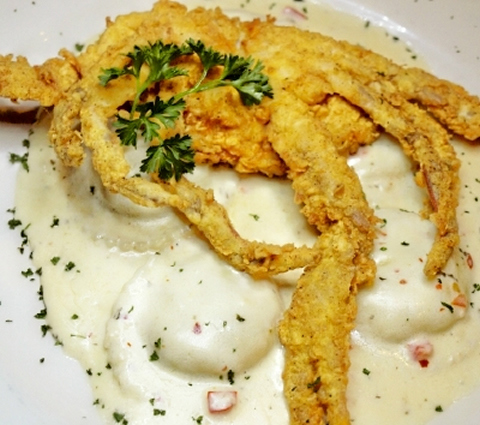
Our annual survey of seafood in Southeast Louisiana this year counts down the 33 best seafood species enjoyed in our restaurants, seafood markets, and homes. For the full survey so far, click here. Or use the links at the bottom to move up and down the list.

#4: Soft-Shell Crabs
No food illustrates how fortunate we avid eaters are to live in Louisiana. Everywhere else, the very idea of a soft-shell crab is attended by connotations of rarity and exotica. The stuff of ambitious restaurants whose dishes require a paragraph to explain. Have you ever seen a soft-shell crab on the menu of a national chain restaurant? But around here, we eat them all over the place, down to poor boy sandwiches from neighborhood joints.
Soft-shell crabs are absurdly delectable. We human Orleanians are not the only ones who think so. Every creature that eats crabs relishes these. It's a wonder any crabs make it past that vulnerable stage.
Soft-shell crabs are just regular blue crabs molting their old, too-small shells. Almost all are farm-raised. In the wild, crabs that have just shed hide themselves well, and can't be caught by normal means. Farmers can tell when their charges are about to molt, and from that point on they observe them closely. Right after it doffs its old shell, the crab is taken out of the water and begins its final trip. Otherwise, the shell would stiffens and get "papery."
Buster crabs are a special subset of soft-shells. A buster was on the verge of molting, but taken from the water before it does. The shell is removed manually, usually resulting in the loss of the legs and claws. But it denies the crab the chance to pump itself up with water. The result is meat that's significantly richer and more flavorful than in a small non-buster soft-shell crab.
Crabs are one of those rare foods that get better as they get bigger. A gigantic soft-shell crab contains, among many other wonderful things, two massive jumbo lumps of a size one rarely gets in straight crabmeat dishes. I'd prefer one "whale" (as they're known to the trade) to two smaller ones any day, even if the two smaller ones together weighed significantly more than the big one.
The hardest part of preparing a soft-shell crab is cleaning it. You have to open the underside and remove the "dead-man's fingers" (the gills, which really do look like their nickname) and the sand sac. Some places just leave the crab as is, and what you get is notably flattened. Some places stuff it with crabmeat stuffing. For a long time at Commander's Palace (and maybe still), they jammed a couple of shrimp in there. My favorite solution: put some crabmeat inside.
No cooking method is better for soft-shell crabs than deep-frying. I've occasionally had broiled or grilled soft-shell crabs that were as good as fried. But never better, and usually worse.
The best recipe ever devised for soft-shell crabs was created by Chef Roland Huet, the original chef of the now-extinct Christian's. He cold-smoked the softies, then fried them and served them with brown butter. It was so good that Redemption—the new restaurant in Christian's old church in Mid-City--was forced by popular demand to add the dish to its own, otherwise different menu.
Another genius in the annals of soft-shell crabs was chef Warren LeRuth. He topped his big fried soft-shell crabs with jumbo lump crabmeat in butter. Crab on crab. It raised the soft-shell crab to the level of apotheosis. The idea spread, and now we have another reason to be thankful for where we live.
This is the time of year when the first and best soft-shells begin to appear. The crabs are stuffed with delicious white meat and go down good. With the warmer water temperatures, they should be more common day by day. I hope the restaurant you go to gives you two of them.

Soft-Shell Crab with Crabmeat Meuniere
Few dishes inspire the eye-popping anticipation that a large, golden brown soft shell crab does. It has such intrinsic excellence that any elaborate preparation diminishes it. The standard (and best) preparation is to dust the crab with seasoned flour and fry it. All it really needs in the way of a sauce is a little brown butter, and perhaps a topping of some extra jumbo lump crabmeat.
- 4 large soft-shell crabs
- 1 tsp. salt
- 1 tsp. white pepper
- 2 cups all-purpose flour
- 1 cup milk
- 1 whole egg
- Vegetable oil for frying
- 1 stick butter
- 1 Tbs. freshly-squeezed lemon juice
- 1/2 tsp. Worcestershire sauce
- 1/2 lb. lump crabmeat
1. Wash the crabs and shake out any water from inside the shell. Remove the "dead man's fingers" (the gills) from underneath the shell. With scissors, and cut off the eyes and mouthparts.
2. Heat vegetable oil in a large heavy kettle to 375 degrees.
3. Blend salt and pepper into flour, and coat each crab lightly with the flour mixture.
4. Combine the milk and egg, then dip the floured crabs into this mixture. Coat crabs again with the seasoned flour.
5. Place a crab top side down on the end of a long-handled cooking fork. (Do not skewer it.) Let the legs and claws dangle. Lower all but the body into the hot oil. Hold that position for about fifteen seconds, and then carefully flip the crab backwards into the oil. Fry two at a time until golden brown, and drain. (Let the heat of the oil recover before frying the next batch.)
6. In a skillet, cook the butter over low heat until it stops bubbling, and the milk solids at the bottom just begin to brown. Carefully add the lemon juice and Worcestershire (this will cause the butter to foam!) and cook until the foaming subsides. Add the crabmeat and sauté 30 seconds. Spoon butter and crabmeat over hot fried crabs.
Serves four.